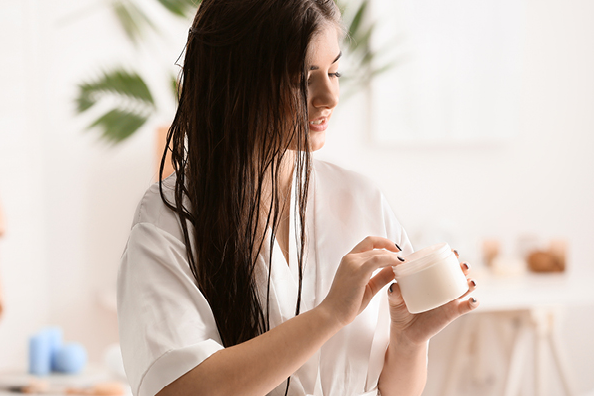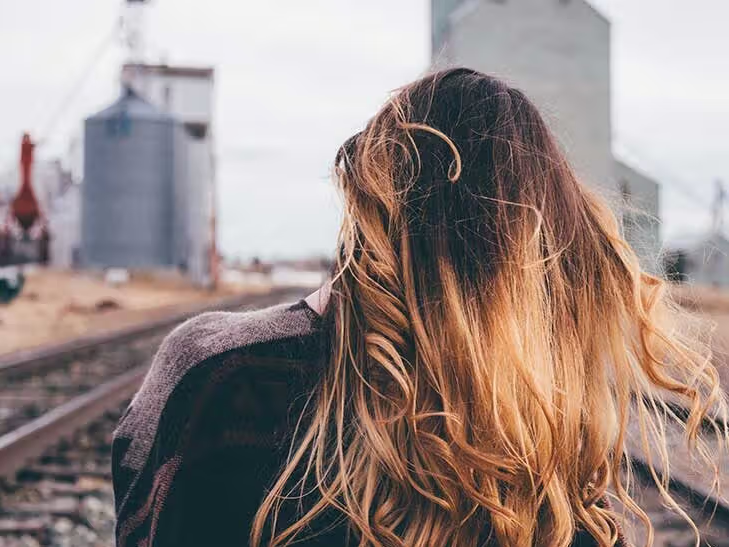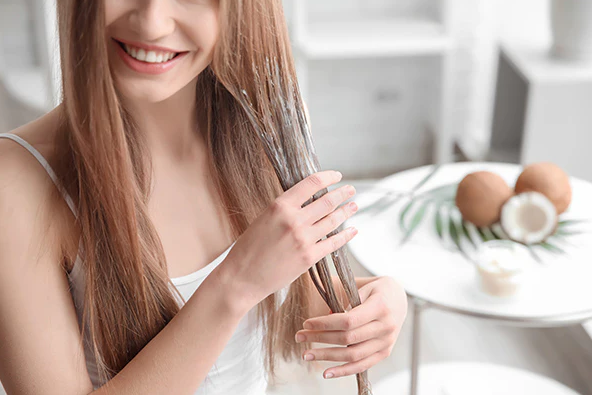Although butter has long been used as a versatile cooking ingredient, you might not be aware of its health benefits for your hair. The question, “Is applying butter good for hair?” has been asked by many. Yes, provided that it is incorporated into a well-balanced hair care regimen and used sparingly. Chebe butter is one variety of butter that has grown in popularity recently. This butter, which comes from the chebe plant, is well-known for its ability to moisturize and possibly encourage hair growth. Thus, continue reading to find out more if you’re curious about how to apply Chebe butter to hair.
Table of Contents

Types of Hair Butter
Two popular varieties of butter that are good for hair are shea and peanut butter. The nuts of the shea tree are used to make shea butter, which is prized for its moisturizing qualities. Its vitamin and fatty acid content nourishes hair and supports general health. Apply a small amount of shea butter to the ends of your hair after warming it between your palms. It can make your hair feel softer and easier to manage by adding shine and reducing frizz.
Conversely, peanut butter is a common pantry item that has additional health benefits for your hair. It has a lot of protein, which is necessary for thick, healthy hair. Applying a generous amount of peanut butter to damp hair and leaving it on for approximately 15-20 minutes can be used as a hair mask. After, give it a thorough rinse to get rid of any leftovers. The nourishing and moisturizing properties of peanut butter’s natural oils can help hair feel conditioned and silkier. If you have a nut allergy, proceed with caution before applying peanut butter to your hair.
Benefits to Nutrition
- Essential Fatty Acids: The omega-3 and omega-6 fatty acids found in butter support the general health and strength of hair.
- Vitamins A and E: These nutrients help maintain a healthy scalp, which may lessen dandruff and promote hair development.
- Butter’s inherent emollients aid in retaining moisture, preventing dryness and encouraging hydration. This contributes to its moisturizing properties.
- Antioxidants: Butter’s antioxidant content may shield hair from oxidative stress and environmental harm.
- Protein Content: Trace amounts of protein found in butter can help to maintain the general strength and structure of hair.
- Saturated Fats: Butter’s saturated fats can act as a barrier to prevent moisture loss, but moderation is still advised.
- Minerals (like zinc): Butter has minerals that help maintain a healthy scalp environment, which may lessen flakiness and itching.
- Anti-Inflammatory Properties: Some of the compounds in butter have anti-inflammatory qualities that can help calm irritated scalps.
- Natural Shine Enhancer: Butter can give hair a healthy, vibrant sheen that enhances its natural shine.
- Increased Elasticity: Using butter on a regular basis can make hair more elastic, which lowers the chance of breakage and split ends.
Recall that each person’s reaction to these nutritional advantages may differ, so it’s important to take into account individual preferences and hair types when adding butter to a hair care regimen.

Properties that Moisturize
When it comes to hair care, shea and cocoa butter are well known for their remarkable moisturizing qualities. In the beauty industry, shea butter’s benefits for hair are well known. Shea butter, which is rich in vitamins A and E, deeply hydrates and nourishes hair by penetrating the shaft. It aids in retaining moisture, giving brittle and dry hair its original vibrancy back. In addition, shea butter functions as a natural sunscreen, shielding hair from damaging UV rays and averting sun-related damage. It also helps to add shine and lessen frizz, which makes the hair easier to manage.
In a similar vein, cocoa butter is well known for its ability to moisturize hair. Cocoa butter, which is high in fatty acids, creates a barrier around hair follicles to keep moisture in and stop excessive water loss. This lessens brittleness and dryness by preserving the natural moisture balance of the hair. Antioxidants found in cocoa butter also strengthen the hair shaft, encourage is applying butter good for hair hair growth, and shield the hair from harm from the environment. Its calming qualities also aid in reducing itching and irritation of the scalp, providing a favorable environment for hair growth.
Possible Negative Effects “Is Applying Butter Good for Hair?”
- Weighing Down Hair: Too much butter, especially on the roots, can make hair appear greasy and feel heavy.
- Difficulty Washing Out: Butter’s richness may make it difficult to wash out entirely, leaving behind a residue that can have an impact on the cleanliness and texture of hair.
- Dust and Dirt Attraction: Butter’s oily texture may draw dust and dirt particles, increasing the hair’s vulnerability to outside contaminants.
- Risk of Scalp Irritation: Certain ingredients in butter have the potential to cause allergic reactions or irritation of the scalp in some people.
- Not Suitable for Every Hair Type: Butter is applying butter good for hair is good for some hair types, but not all of them, especially for finer-textured or oilier-prone hair types.
- Possibility of Clogged Pores: Butter may clog scalp pores and hair follicles, impairing the production of sebum naturally.
- Unpleasant Odor: Butter can have a distinct smell that some people find unpleasant, depending on its type and quality.
- Heat Sensitivity: Butter can become melted is applying butter good for hair in warm weather, making its application messy.
- Color Alteration: Applying butter to colored hair on a regular basis may change the color, particularly for lighter shades.
- Cost consideration: Some people may find this hair care method less cost-effective because premium, natural butters can be pricey.
Before using butter widely, it’s important to take into account these possible side effects and find out how your hair reacts to it by doing a patch test. Reducing the amount and timing of applications can also assist in allaying some of these worries.

DIY Hair Masks
| Mask | Ingredients | Instructions |
|---|---|---|
| Shea Bliss | Shea butter, coconut oil, honey | 1. Melt shea butter and mix with coconut oil. |
| 2. Add honey and blend until smooth. | ||
| 3. Apply to hair, leave for 30 mins, then rinse. | ||
| Cocoa Shine | Cocoa butter, olive oil, yogurt | 1. Melt cocoa butter and mix with olive oil. |
| 2. Add yogurt to create a creamy consistency. | ||
| 3. Apply evenly, leave for 20 mins, then wash out. | ||
| Avocado Silk | Avocado, banana, olive oil | 1. Mash avocado and banana together. |
| 2. Mix in olive oil until a paste forms. | ||
| 3. Apply, leave for 25 mins, then rinse thoroughly. | ||
| Honey & Oats | Honey, oats, milk | 1. Mix honey, oats, and milk to form a paste. |
| 2. Apply, gently massage, leave for 15 mins, rinse. | ||
| Coconut Nour | Coconut oil, egg, lemon juice | 1. Beat egg, add coconut oil and lemon juice. |
| 2. Apply to hair, cover with a cap, wait 30 mins. | ||
| 3. Rinse with lukewarm water and mild shampoo. | ||
| Minty Fresh | Peppermint oil, yogurt, aloe vera gel | 1. Mix all ingredients until well combined. |
| 2. Apply to hair and scalp, leave for 20 mins. | ||
| 3. Rinse thoroughly for a refreshed feel. | ||
| Lemon Zest | Lemon juice, olive oil, honey | 1. Mix lemon juice, olive oil, and honey together. |
| 2. Apply to damp hair, leave for 15 mins, then rinse. | ||
| Herbal Infu | Rosemary, chamomile, green tea | 1. Infuse herbs in hot water, cool and strain. |
| 2. Apply the herbal infusion to clean, damp hair. | ||
| 3. Allow it to sit for 20 mins, then wash out. |

From a Scientific Angle
Despite the paucity of empirical evidence supporting the benefits of using butter on hair, certain scientific studies indicate that butter’s specific properties may support the health of hair. According to research, butter’s high fat is applying butter good for hair content acts as a is applying butter good for hair barrier to shield the hair shaft from damage and help it retain moisture. Additionally, butter’s vitamin A, E, and K content may have antioxidant benefits that could encourage hair growth and lessen inflammation on the scalp. It’s crucial to remember that additional study is required to completely comprehend the precise effects of butter on hair health.
The application of butter to hair raises some scientific questions in addition to possible advantages. One major disadvantage of butter’s high fat content is that it can cause hair to become overly greasy and heavy. This may result in the hair appearing flat and lifeless and lacking volume. Furthermore, applying butter to their scalp or hair may make some people more sensitive to allergic reactions or skin irritations. To make sure there are no negative reactions, it is therefore is applying butter good for hair advised to perform a patch test prior to applying butter to the entire scalp or hair.
Application Techniques
1. Start with Clean Hair
To get the most out of the butter, start with freshly washed hair. Better absorption and less interference from other styling products are made possible by clean hair.
2. Employ Minimal Amounts
Spread a small amount of butter on there at first. If necessary, you can always add more, but starting with less runs the risk of making your hair appear greasy.
3. Concentrate on Dry Areas and Ends
Apply butter primarily to the ends of your hair and any areas that are dry or damaged. The moisturizing qualities of the butter are especially beneficial to these areas.

4. Heat the butter
If the butter is solid, preheat it in a double boiler or between your palms. This guarantees a more even application and facilitates improved dispersion throughout your hair.
5. Rinse out or leave in?
Choose whether to rinse out the butter as a treatment or leave it in as a styling tool. Try a few different approaches to determine which works best for your hair type and preferences.
Recall that individual outcomes may differ and that these are only general recommendations. For optimal results, customize your application is applying butter good for hair technique based on how your hair reacts.
Customer Feedback and Testimonials
| User | Hair Type | Experience |
|---|---|---|
| 1 | Straight | “Butter made my hair softer and more manageable.” |
| 2 | Curly | “Initial greasiness, but hair felt hydrated later.” |
| 3 | Wavy | “Not suitable for my hair, felt heavy and sticky.” |
| 4 | Coily | “Great for deep conditioning, reduced frizz.” |
| 5 | Straight | “Improved shine, but caused scalp irritation.” |
| 6 | Curly | “Moisturized curls, but took time to wash out.” |
| 7 | Wavy | “Enhanced texture, had to adjust quantity.” |
| 8 | Coily | “Reduced breakage, added a natural sheen.” |
| 9 | Straight | “Not suitable for fine hair, weighed it down.” |
| 10 | Curly | “Mixed results, needed to find the right balance.” |

Frequently Asked Questions(FAQs)
Q.How can butter be applied to my hair?
Butter can be applied to hair in a variety of ways. It can be used as a deep conditioning treatment, applied straight to your hair as a leave-in conditioner, or mixed into homemade hair masks.
Q.Which varieties of butter are suitable for my hair?
Shea butter, cocoa butter, mango butter, and avocado butter are a few of the butter varieties that are good for hair. Every variety has special qualities and advantages of its own.
Q.What nutritional advantages does applying butter to hair have?
Butter has a lot of fatty acids and vitamins that can strengthen and nourish your hair. It can lessen breakage, increase hair elasticity, and encourage strong, healthy hair growth.
Q.How does butter help to hydrate hair?
Butter’s inherent emollient qualities is applying butter good for hair aid in retaining moisture and warding off dryness. Your hair may get intense hydration from it, becoming shinier, softer, and easier to manage.
Q.Are there any possible downsides to applying butter to your hair?
Even though butter is very good for hair, not everyone will benefit from it. It might be too thick or oily for some people, particularly those with fine or oily hair. It is best to conduct a patch test prior to applying butter throughout your entire hair.
Q.Is it possible to make my own butter hair masks?
Yes, you can use butter as the base ingredient to make your own DIY hair masks. You can modify butter to target particular hair issues by mixing it with additional natural ingredients like yogurt, honey, or essential oils.
Q.Is there any proof from science to back up using butter on hair?
Despite the paucity of scientific studies specifically on butter for hair, butter’s known properties and nutritional makeup make it a promising ingredient for hair care products. However, each person’s experience may differ.

Q.Are there any tricks for putting butter on hair?
Use a small amount of butter at first and add more gradually as needed when applying it to your hair. Avoid touching your scalp to avoid being is applying butter good for hair overly oily and instead concentrate on the length and ends of your hair. To make sure the butter is distributed evenly throughout your hair, comb or massage it in.
Conclusion
In conclusion, even though putting butter on hair may have advantages like hydration and nourishment, it’s important to take into account different hair types and preferences. While some might find it a useful addition to their hair care regimen, others might encounter disadvantages. Carefully experimenting, being aware of individual needs, and using butter sparingly could result in hair that is healthier and more vibrant. Individual experiences may differ, as with any beauty regimen, so it’s best to watch how butter behaves on one’s hair and modify application as necessary for best effects.




